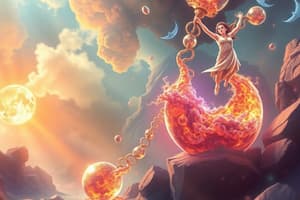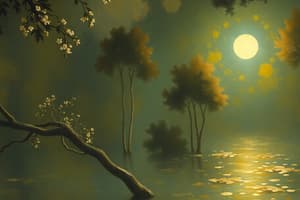Podcast
Questions and Answers
What is the primary function of a limiting reactant in a chemical reaction?
What is the primary function of a limiting reactant in a chemical reaction?
- It determines the amount of product produced. (correct)
- It can be completely consumed without affecting product yield.
- It does not participate in forming the final product.
- It is always the most abundant reactant.
Which of the following best describes percent yield?
Which of the following best describes percent yield?
- The total mass of products divided by the total mass of reactants.
- The ratio of actual yield to stoichiometric yield. (correct)
- The ratio of theoretical yield to the sum of all yields.
- The calculated mass of reactants after completion of the reaction.
How does increased temperature generally affect the rate of dissolution?
How does increased temperature generally affect the rate of dissolution?
- It provides more kinetic energy, enhancing dissolution. (correct)
- It has no effect on gas solubility.
- It decreases the kinetic energy of molecules.
- It causes solutes to segregate from solvents.
What role does the molar ratio play in identifying limiting and excess reactants?
What role does the molar ratio play in identifying limiting and excess reactants?
What does the molecular mass of a compound represent?
What does the molecular mass of a compound represent?
What does molarity specifically quantify?
What does molarity specifically quantify?
Which statement about molarity is true?
Which statement about molarity is true?
Under standard temperature and pressure (STP), what volume does one mole of gas occupy?
Under standard temperature and pressure (STP), what volume does one mole of gas occupy?
What is Avogadro's number used to define?
What is Avogadro's number used to define?
Which of the following is NOT a variable needed to define the physical state of a gas?
Which of the following is NOT a variable needed to define the physical state of a gas?
What is boiling point elevation a result of?
What is boiling point elevation a result of?
Which property describes the motion of solvent molecules through a semi-permeable membrane?
Which property describes the motion of solvent molecules through a semi-permeable membrane?
What defines a saturated solution?
What defines a saturated solution?
In which type of reaction do two or more substances combine to form a new compound?
In which type of reaction do two or more substances combine to form a new compound?
Which best characterizes a Bronsted acid?
Which best characterizes a Bronsted acid?
What is a defining feature of an amphoteric substance?
What is a defining feature of an amphoteric substance?
Which of the following reactions will result in a solution with a pH greater than 7?
Which of the following reactions will result in a solution with a pH greater than 7?
What defines a strong electrolyte in solution?
What defines a strong electrolyte in solution?
Which of the following describes a saturated solution?
Which of the following describes a saturated solution?
How can molality be defined?
How can molality be defined?
What is the main characteristic of colligative properties?
What is the main characteristic of colligative properties?
Which of the following statements about nonelectrolytes is correct?
Which of the following statements about nonelectrolytes is correct?
What type of reaction occurs when two solutions with dissolved salts are mixed?
What type of reaction occurs when two solutions with dissolved salts are mixed?
Which factor does NOT influence the ease of dissolution of a solute into a solvent?
Which factor does NOT influence the ease of dissolution of a solute into a solvent?
What is the correct formula to calculate molarity?
What is the correct formula to calculate molarity?
Flashcards are hidden until you start studying
Study Notes
Molarity and Solutions
- Molarity is defined as the number of moles of solute per liter of solution.
- A solution consists of a solute (substance being dissolved) and a solvent (substance doing the dissolving).
- In seawater, water serves as the solvent, while salts like sodium chloride are the solutes.
- Molar volume indicates that one mole of any gas occupies 22.4 liters at standard temperature and pressure (0°C, 1 atmosphere).
- At STP, gas reactions are analyzed using the ideal gas law and require knowing molar volume along with pressure and temperature.
Reactants in Chemical Reactions
- Limiting reactants determine the maximum amount of product that can be formed in a chemical reaction.
- Excess reactants are those that remain after the reaction has completed.
- Conversion from grams to moles is necessary to equate the coefficients of the balanced equation to ascertain limiting and excess reactants.
- Percent yield compares the actual yield to the theoretical yield to gauge reaction efficiency.
Percent Composition and Empirical Formulas
- Percent composition calculates the mass percentage of each element in a compound based on its molecular mass.
- The empirical formula represents the simplest integer ratio of elements in a compound.
- Applications of percent composition include food labeling and quality control in various industries.
Dissolution and Solubility
- Dissolution involves the solute breaking down into particles and forming a homogeneous solution with the solvent.
- Factors affecting dissolution rate include polarity, temperature, pressure, and surface area of the solute.
- Polar solvents dissolve polar solutes effectively, while nonpolar solvents dissolve nonpolar solutes.
- A saturated solution contains the maximum concentration of solute that can dissolve under given conditions.
Electrolytes and Nonelectrolytes
- Electrolytes dissociate into ions in solution, conducting electricity, whereas nonelectrolytes do not.
- Strong electrolytes fully dissociate in water (e.g., sodium chloride), whereas weak electrolytes partially dissociate (e.g., vinegar).
- Conductivity in electrolyte solutions is dependent on solute concentration.
Colligative Properties
- Colligative properties depend on solute-solvent ratio; they include boiling point elevation, freezing point depression, vapor pressure, and osmotic pressure.
- Boiling point elevation raises the boiling point of a solution with added solute, while freezing point depression lowers it.
- Vapor pressure is calculated using Raoult's law, and osmotic pressure describes solvent movement through a semipermeable membrane.
Types of Reactions
- Synthesis reactions combine multiple substances to form a new compound, whereas decomposition reactions break compounds into multiple products.
- An acid is defined as a proton donor, while a base is a proton acceptor—this is key in acid-base chemistry.
- Amphoteric substances can act as either acids or bases depending on the situation.
Summary of Acid-Base Reactions
- A strong acid reacting with a strong base produces a neutral salt and water, typically maintaining a pH of 7.
- The understanding of acids and bases extends beyond simple definitions to detailed interactions and behaviors in various chemical processes. ### Acid-Base Reactions
- Strong acid and weak base reactions form acidic solutions (pH < 7).
- Weak acid and strong base reactions yield basic solutions (pH > 7).
- Weak acid and weak base reactions produce neutral solutions (pH = 7).
- Acid-base neutralization typically results in salt and water with a neutral pH (7).
- Examples: breathing into lime water, hydronium ions reacting with hydroxyl ions, baking powder in cookies.
Water Autoionization
- Water can ionize to form hydronium (H₃O⁺) and hydroxide (OH⁻) ions, known as autoionization.
- The equilibrium constant for water's autoionization is Kw = 10⁻¹⁴ at 25°C.
- At this temperature, [H₃O⁺] and [OH⁻] concentrations in pure water are both 10⁻⁷ M.
pH Scale
- pH scale ranges from 0 to 14, measuring acidity and basicity.
- Solutions with pH 0-6 are acidic, 7 is neutral, and 8-14 are basic.
- Lower pH values indicate stronger acids; higher values indicate stronger bases.
Coordination Compounds
- Coordination compounds consist of a central metal ion bonded to ligands.
- Covalent bonds between metal ions and ligands are called coordination covalent bonds.
- Oxidation number indicates the charge on the metal in a coordination complex.
- Coordination number refers to the number of atoms bonded to the metal ion, determining the compound's shape.
Precipitation Reactions
- A precipitate forms when two soluble salts create an insoluble product.
- Precipitation occurs when a substance's concentration exceeds its solubility.
- Positive and negative ions combine in a solution to form solids (precipitates).
- Types of precipitation reactions include in solution, agar gel, and agar gel with an electric field.
Oxidation Numbers
- Oxidation numbers indicate electrons gained or lost during reactions, helping formulate compounds and balance equations.
- Key rules include: free elements = 0, monatomic ions = ion charge, sum in neutral compounds = 0.
- Group IA metals have +1 oxidation state, IIA +2, and VIIA -1, with oxygen typically at -2.
Redox Reactions
- An oxidizing agent gains electrons and decreases in oxidation state; a reducing agent loses electrons and increases in oxidation state.
- Redox reactions involve simultaneous oxidation and reduction.
- Types include combination, decomposition, combustion, and displacement reactions.
Electrochemical Cells
- Electrochemical cells convert chemical energy to electrical energy, consisting of two electrodes in an electrolyte.
- The cathode accepts electrons, while the anode donates them.
- There are two types: Galvanic (spontaneously generating electron flow) and Electrolytic (utilizing external energy).
- Cell notation represents the anode on the left and cathode on the right, with half-reactions occurring at each electrode.
Studying That Suits You
Use AI to generate personalized quizzes and flashcards to suit your learning preferences.




